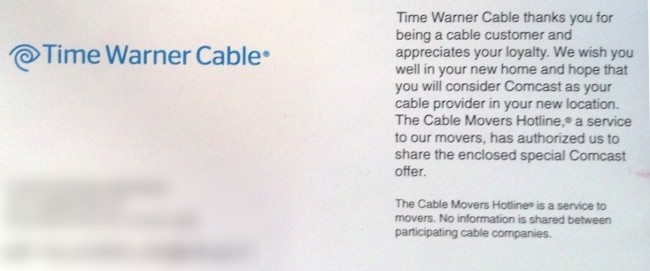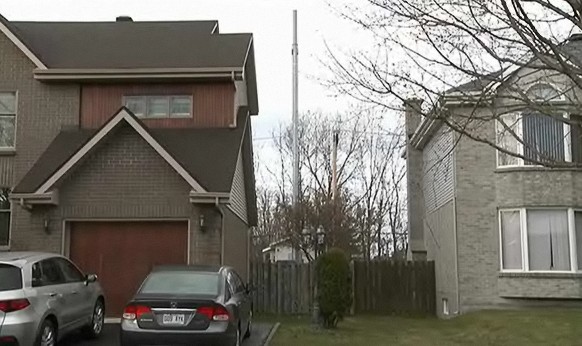Other than the original “five families” that ruled New York’s underworld from the 1930s on, it is hard to find a level of collusion higher than in today’s telecommunications marketplace. It’s a veritable No-Fight Club, and the first rule is cable companies don’t fight with other cable companies. (The second is phone companies don’t compete with other phone companies.) Everyone has their respective territory, and only the bravest interlopers dare to intrude on the cozy duopoly territory most North Americans endure, at least until the boys can drop a dime with the feds and put the kibosh on them with anti-community broadband laws or buying them out and telling them to scram.
But Time Warner Cable does not have to rub it in. But they do anyway, see.

One reader of the Consumerist was perturbed when Time Warner Cable sent him a letter congratulating him for his decision to move... and welcoming him to consider Comcast Cable as his new provider.
Do you think Ford would ever send you a letter suggesting you give Toyota a try? Or would McDonald’s ever shoot you an e-mail telling you to check out the lovely Burger Kings in your new neighborhood? Of course not. So why would the cable industry not care which company you choose?
Consumerist reader Mike recently moved out of an area where he had no choice for cable TV other than Time Warner Cable to a town where Comcast is the only option.
[…] “What makes me even angrier is that they spent money printing and mailing this letter that only serves to remind me that I don’t have any choice!”
 That mailer came courtesy of something called, “The Cable Movers Hotline,” which sounds like a clearinghouse for consumers searching for a moving company. Indeed, the website for the group even includes video moving tips courtesy of HGTV’s Lisa LaPorta, David Gregg, senior editor, Behindthebuy.com, and interior designer Libby Langdon.
That mailer came courtesy of something called, “The Cable Movers Hotline,” which sounds like a clearinghouse for consumers searching for a moving company. Indeed, the website for the group even includes video moving tips courtesy of HGTV’s Lisa LaPorta, David Gregg, senior editor, Behindthebuy.com, and interior designer Libby Langdon.
What’s the real story, morning glory? Don’t blow your wig, sister. It’s coming.
In fact, the “Hotline” is a creature of CTAM – the Cable & Telecommunications Association for Marketing, a Maryland-based trade group that includes most of the nation’s largest cable operators as members. CTAM’s “Hotline” is the cable industry’s attempt to make sure that fresh start in your new cave doesn’t include service from the dirty rat phone company or some grifter satellite TV provider with a flim-flam rebate scam. With none of CTAM’s members willing to compete head-on with other cable operators, trading customers back and forth doesn’t hurt business, keeps the butter and egg man counting up those bills, and helps bleed you dry.
A 21st century clip joint? You said it!


 Subscribe
Subscribe






